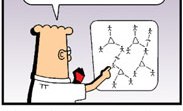Thursday, December 21, 2006
Merry Mazel Tov: SNA fun for the whole family
It's a pretty good exam, which makes the grading tolerable. If you're bored this Christmas weekend, give it to your kids and let the fun begin!
Thanks also to Simon Clay Michael for teaching me the handy phrase "Merry Mazel Tov."
This work is licensed under a Creative Commons Attribution-ShareAlike 2.5 License and is copyrighted (c) 2006 by Connective Associates except where otherwise noted.
Tuesday, December 19, 2006
Net Gains: handbook by Plastrik and Taylor
Net Gains
A Handbook for Network Builders
Seeking Social Change
By Peter Plastrik and Madeleine Taylor
—Sponsored by the Wendling Foundation—
From the INTRODUCTION to NET GAINS
It is intended to join, complement, and spur other efforts to capture and make widely available what is being learned in the business, government, and civil sectors about why and how to use networks, rather than solitary organizations, to generate large-scale impact.
We start with the point of view that networks provide social-change agents with a fundamentally distinct and remarkably promising “organizing principle” to use to achieve ambitious goals. Given the complexity and enormity of social problems, the unrelenting pressure to reduce the cost of creating and implementing solutions, and the recent proliferation of small nonprofit organizations, networks offer a way to weave together or create capacities that get better leverage, performance, and results.
Relying on networks to generate social change is not new to philanthropy and nonprofits. Many foundations have funded the civil rights, feminist, and consumer movements for decades and more recently have assembled “learning networks” of grantees that work together to innovate and improve their practices. As Jon Pratt, executive director of the Minnesota Council of Nonprofits, points out, “community organizers and grass roots organizations have applied network concepts for years.”
But something new and important is afoot. The nonprofit and philanthropic sectors are under growing demand to do more and to do better. The number of nonprofit organizations is expanding substantially, as are the tasks the civil sector undertakes in light of government downsizing. “We’re seeing growth of nonprofit organizations, but not much change in the systems they are trying to impact,” says Pat Brandes, a foundation executive in
Foundations, a crucial capital market for nonprofits, and governments that contract with nonprofits increasingly seek improved impact, leverage, and “return on investment.” Nonprofits are routinely expected to be more strategic, entrepreneurial, and “high performing,” and to focus on producing outcomes. Some efforts to increase the impact of nonprofits, such as “venture philanthropy,” have focused on strengthening individual organizations to be more effective and efficient. But, as the Maine Community Foundation notes, this approach can be inefficient, since its capacity-building resources are invested across many organizations without regard for redundancy and overlap among the organizations. Meanwhile, foundations typically fund programs rather than methods of delivery, but more of them are forming their own networks, rather than going it alone, to develop their strategies and pool their resources.
In this shifting context for the civil sector, networks represent a fundamentally different response to achieve efficiency and effectiveness. They should not be dismissed as merely the latest fad promoted by business leaders, consultants, and foundations who don’t understand the uniqueness of the nonprofit world. “Network strategies offer a powerful set of tools to manage the key tasks and challenges faced by nonprofits,” argues Jon Pratt. “Network thinking offers powerful analytic and strategic tools for nonprofit boards and managers to increase the stability, influence and autonomy of their organizations.”
Most of us have networking in our blood. We build personal networks and connect with other individuals or organizations to get things done that we can’t do by ourselves. But there’s much more to network building than this instinct to link. Building a network is a practice about which much has been learned from the experiences of network builders themselves and the experiments and insights of researchers in mathematics, physics, anthropology, and other disciplines.
This is news to most of the social entrepreneur-network builders we meet. Networks in the nonprofit sector are rarely organized to take full advantage of what networks can do. “We in the nonprofit sector always say, ‘We connect,’ but we don’t really know much about connecting,” observes Marion Kane, executive director of the Barr Foundation.
For many decades, the overriding organizing principle of the social-change sector, as with business and government, has been the stand-alone organization. This focus has driven the understanding of management and leadership; the CEO or Executive Director at the helm of the lone organization has been an icon of the age. But hierarchical, organization-centric is losing its sway. Many people, even in the largest, most venerable organizations, recognize now that to gain greater impact they have to let go of organization-centric ideas about how the world works, and they are adopting network-centric thinking.
TABLE OF CONTENTS
Introduction
The Authors
Acknowledgments
Part I: Is a Network Approach Right for You?
1. Starting Points 11
2. What We Mean by Network 14
3. The Difference a Network Makes 18
4. The Business Case for Social-Change Networks 24
5. Gut Check: What It Takes to Build Networks 28
Part II: Organizing Networks: Seven Decisions
6. Three Networks in One: Connection, Alignment, and Production Nets 33
7. Reasons that Bind: Collective Value Propositions 39
8. Who’s In, Who’s Out: The Privilege of Membership 45
9. Who Decides What and How: Network Governance 48
10. The Shape of Things To Come: Structures of Networks 51
11. Rules to Live By: Operating Principles for Network Building 58
12. The Different Roles of Network Builders 61
13. When Funders Organize Networks 64
Part III: Managing a Network’s Development: Five Tasks
14. Weaving Connections: Ties that Bind 68
15. Facilitating Alignment: Production Agreements 74
16. Coordinating Production: Who Does What 78
17. Operating the Network: Management Issues to Anticipate 81
18. Taking a Network’s Pulse: Monitoring and Evaluation 87
19. Visualizing Networks: Maps that Reveal 97
Part IV: Net Gains in the Social-Change Sector
20. Building the Civil Sector’s Networks: Five Strategies 102
A Network Glossary 107
Resources for Network Builders 109
End Notes
The Authors
Wednesday, December 13, 2006
Promote cooperation with both carrots and sticks
How much would you invest in such a fund? The answer clearly depends on how much everyone else is going to invest. Can you trust your co-investors to put in at least as much as you do?
A few weeks ago I invited my students to participate in this experiment by investing their hard-earned grade points in exactly such a fund, as a homework exercise (HW10, to be exact). To protect against individual ruin, I limited the maximum investment to 2 points out of 150 earned over the course of the semester. By requesting deposits in "cents" (0.01 of a point), I gave students a range of 0-200 to choose from.
Here are the results. You can see that many students chose to invest 200 cents (the maximum allowed) but there were enough free-riders in the fund so that even after doubling, the fund returned less than 200 cents to each investor.
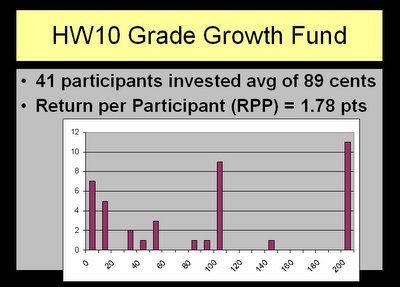 In other words, many students lost 0.22 points by investing in the fund.
In other words, many students lost 0.22 points by investing in the fund.Claire Reinelt alerted me yesterday to German researchers B. Rockenbach and M. Milinski, who did a very similar study and got their results published in Nature just this week. Their study also allowed fund investors to dedicate a portion of their deposit to punishing free-riders on the fund. This option turns out to be a critical ingredient to designing a fund with maximal collective gain. See also this cute Boston Globe article on the study: "Want cooperation? Carrots and sticks get the best results."
This work is licensed under a Creative Commons Attribution-ShareAlike 2.5 License and is copyrighted (c) 2006 by Connective Associates except where otherwise noted.
Tuesday, December 12, 2006
BU students ponder the Internet and social epidemics
Their last homework assignment was writing a short essay on how the Internet affects social epidemics in America. During the semester we explored this question in many ways--by blogging and programming with HTML and JavaScript, by studying the mathematics of information diffusion and economic externalities, and by experiencing social epidemics within our own classroom (of 62 students) and reflecting.
The following two student essays do a great job of digesting the material of the semester and addressing the question, "does the Internet make future social epidemics more or less likely?"
- Those of you who wonder why such a question is even worth asking should start with this essay on how the Internet limits epidemics, written by Drew Phillips '09;
- Here is an excellent essay on how the Internet increases epidemics, written by A Garrett Robertson.
Saturday, October 21, 2006
Dilbert uses SNA to improve productivity
Somewhat reminiscent of another image in my archives.

This work is licensed under a Creative Commons Attribution-ShareAlike 2.5 License and is copyrighted (c) 2006 by Connective Associates except where otherwise noted.
Monday, October 16, 2006
See change in your own organization
This video is my overdue response to questions raised by the Accenture demo video from a few months ago. That demo video launched a thread discussed at some length on the Value Network Google discussion group. I found it interesting how that thread focused largely on the challenges of enterprise-wide data-mining. To that thread I would add the equally significant observation that anyone can now create and publish his own network stories in video form.
This work is licensed under a Creative Commons Attribution-ShareAlike 2.5 License and is copyrighted (c) 2006 by Connective Associates except where otherwise noted.
Wednesday, September 13, 2006
Those who can't blog, teach blogging
To compensate for my reduced blogging, I am having my students blog for credit. They are going to complement that with basic web programming and some introductory social network analysis.
We started the social network analysis on the very first day of class. I had my students pair off
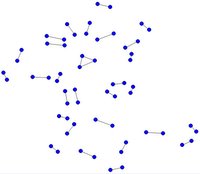 and interview each other about their Internet preferences (PC vs Mac, IE vs Firefox, etc). You can see the resulting map of who paired with whom at right.
and interview each other about their Internet preferences (PC vs Mac, IE vs Firefox, etc). You can see the resulting map of who paired with whom at right.The map of pairings by itself is not so interesting, but it got more interesting at the end of class when I invited everyone to stand up and make an impromptu party at the front of the class. We took note of who clustered with whom. Below you can see red dots representing each of the 13 party clusters. Blue dots connected to red dots are students in the party clusters. Blue dots connected to blue dots are interview pairs from earlier in class.
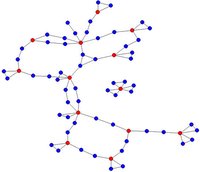 Showing students a map of how they connect with each other on the very first day of class provides a fun and meaningful springboard to consider how their blogs and other websites will be connecting later in the semester.
Showing students a map of how they connect with each other on the very first day of class provides a fun and meaningful springboard to consider how their blogs and other websites will be connecting later in the semester.On another topic... if you're near Boston, come hear "KM meets OD" co-presented by Patti Anklam and me, Thursday evening Sept 14, hosted by the Mass Bay OD Learning Group.
This work is licensed under a Creative Commons Attribution-ShareAlike 2.5 License and is copyrighted (c) 2006 by Connective Associates except where otherwise noted.
Tuesday, September 05, 2006
The New Tastemakers (NY Times)
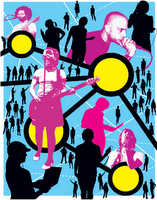 Today I am very busy preparing my first ever lecture at Boston University, where I am about to teach Online Social Networks under the guise of "CS-103: Introduction to Internet Technologies and Web Programmming."
Today I am very busy preparing my first ever lecture at Boston University, where I am about to teach Online Social Networks under the guise of "CS-103: Introduction to Internet Technologies and Web Programmming."Conveniently, last Sunday's NY Times Arts & Leisure section supplied me with my lecture material. Check out this wonderful front-page article on how traditional music experts (FM radio program managers, record label talent artists) are losing power and influence to online services.
Strangely, the front page graphic features a social network map, even though Pandora.com, the most prominent online music service in the article, is not really driven by social network technology. See The Music Genome Project for more.
This work is licensed under a Creative Commons Attribution-ShareAlike 2.5 License and is copyrighted (c) 2006 by Connective Associates except where otherwise noted.
Tuesday, August 29, 2006
The Community of Practice heard round the world
There are parts of Wood's historical analysis that seem aimed more at our current administration than its forebears. Writing after the U.S. invasion of Afghanistan but before Iraq, Wood says:
British disadvantages [in 1775] were immense and perhaps overwhelming.... A well-trained army might have been able to to conquer the American forces, but... America itself was unconquerable. The great breadth of territory and the wild nature of the terrain made conventional maneuverings and operations difficult and cumbersome. The fragmented and local character of authority in America inhibited decisive action by the British. There was no nerve center anywhere whose capture would destroy the rebellion. The British generals came to see that engaging Washington's army in battle ought to be their main objective; but, said the British commander in chief, they did not know how to do it, "as the enemy moves with so much more celerity than we possibly can."For more on how Washington's tactics of 1776 are being used today by Hezbollah, Al Quaeda, and other social action groups, see "Networks, Netwars, and the Fight for the Future," which was originally recommended to me by Kate Ehrlich. When you read this paper, savor the irony of its opening line:
Netwar is an emerging mode of conflict in which the protagonists use network forms of organization, doctrine, strategy, and technology.... The practice of netwar is well ahead of theory, as both civil and uncivil society actors are increasingly engaging in this new way of fighting.This work is licensed under a Creative Commons Attribution-ShareAlike 2.5 License and is copyrighted (c) 2006 by Connective Associates except where otherwise noted.
Friday, August 04, 2006
Online identity verification and two-sided networks
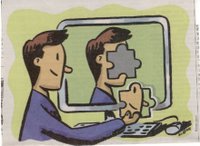 When we interact online, it's increasingly important to know who is on the other side of the screen. There are many services emerging that provide various forms of ID verification, which are covered nicely in the article. The article goes just deep enough to give a quick nod to the forward-looking Higgins Project, which is being led by Parity Communications (mentioned here yesterday) with support from IBM and Novell.
When we interact online, it's increasingly important to know who is on the other side of the screen. There are many services emerging that provide various forms of ID verification, which are covered nicely in the article. The article goes just deep enough to give a quick nod to the forward-looking Higgins Project, which is being led by Parity Communications (mentioned here yesterday) with support from IBM and Novell.It's important to note that ID-verification services are fighting to attract two completely different sets of users. They must enlist websites to license their technology and they must enlist users to register for IDs. Both sides are absolutely essential to any successful ID-verification service.
Several days ago I lunched with Marshall Van Alstyne as he explained this pervasive two-sided business phenomenon, which is old as the hills but only recently something specifically named and studied by economists. Marshall and his colleagues call it a "two-sided network." Stay tuned for a lot more popular business press on this topic in the near future. Meanwhile, you can see Geoffrey Parker's home page for his paper "Two-Sided Network Effects," co-authored with Marshall.
This work is licensed under a Creative Commons Attribution-ShareAlike 2.5 License and is copyrighted (c) 2006 by Connective Associates except where otherwise noted.
Thursday, August 03, 2006
Visualizing organizational change
All that makes it even more impressive that the Accenture Institute for High Performance Business, led by Bob Thomas, has produced a relatively accessible dramatization of how real-time dynamic SNA can be a powerful business tool in the not-too-distant future.
I had the privilege of creating this seven-minute Flash video for Bob, in collaboration with Sarah Maloney of Accenture, Paul Trevithick and Mary Ruddy of Parity Communications and Barry O'Brien of North Shore Communications. You can see our handiwork here.
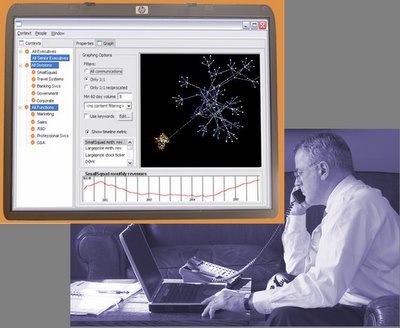 This work is licensed under a Creative Commons Attribution-ShareAlike 2.5 License and is copyrighted (c) 2006 by Connective Associates except where otherwise noted.
This work is licensed under a Creative Commons Attribution-ShareAlike 2.5 License and is copyrighted (c) 2006 by Connective Associates except where otherwise noted.Monday, July 24, 2006
Networks of negative relationships
 As I mentioned in a post on jerks and fools at the office, negative relationships often influence the big picture more than their positive counterparts, and the study of negative-valued social networks is still underappreciated. Professor Joe Labianca is one of the researchers working hardest at "balancing the ledger" to understand social networks that include negative as well as positive relationships.
As I mentioned in a post on jerks and fools at the office, negative relationships often influence the big picture more than their positive counterparts, and the study of negative-valued social networks is still underappreciated. Professor Joe Labianca is one of the researchers working hardest at "balancing the ledger" to understand social networks that include negative as well as positive relationships.Asking someone to name his sworn enemies amongst his co-workers might be impractical. But in "no holds barred" arenas (love, war, etc.) mapping negative relationships is sometimes feasible and almost always more revealing than mapping positive relationships. Just take a look at these network maps of political scandal previously published by the NY Times to see how lame positive-valued network maps can be in comparison to the Middle East map of hatred, above.
This work is licensed under a Creative Commons Attribution-ShareAlike 2.5 License and is copyrighted (c) 2006 by Connective Associates except where otherwise noted.
Thursday, July 20, 2006
Floyd Landis is God

Landis, among the initial favorites to win the Tour de France, seemingly fell from contention yesterday when he "bonked" and lost over ten minutes to his rivals. But today Landis more than rebounded. Singlehandedly, he rode away from everyone and took back all that time (all but 31 seconds). With one time trial stage remaining, Landis must now be considered the Tour de France favorite once again.
Such over-the-top displays of individual athleticism are rare in the Tour de France, where winners typically succeed only thanks to behind-the-scenes sacrifice by their teammates. During last year's Tour de France, I said of cycling that "few Americans appreciate the team dynamics and strategy that are the heart of what road racing is about." It's a sport sophisticated enough to inspire 21st century innovations in the mathematics of game theory.
Nothing was remotely subtle, sophisticated, or behind-the-scenes about Landis's strategy today.
BTW, did I mention that Landis has a degenerative hip disorder and is due for joint replacement as soon as the Tour is over? (Reported last week by NY Times Magazine.)
Go Floyd!
[Update 2: Can anyone confirm the rumor that Blogger.com is going to start testing "Blog of the Day" winners for unnaturally high levels of caffeine?]
This work is licensed under a Creative Commons Attribution-ShareAlike 2.5 License and is copyrighted (c) 2006 by Connective Associates except where otherwise noted.
Wednesday, July 12, 2006
Are you networked for successful innovation?
Based on in-depth study of six projects in the R&D lab of a Fortune 500 corporation, Rizova summarizes four key factors behind successful innovation:
- Strong corporate support
- Open communication without formal reporting
- A "technical star" who is central in the technical-advice network
- A “managerial star” who is central in the organizational-advice network
Rizova acknowledges that these four factors alone are not enough--they must reinforce each other in order to work. She goes on to discuss the complementary values of the technical-advice and organizational-advice networks, and how people's actual roles in these networks can help inform their explictly prescribed roles in the organization.
This article is a must-read for leaders of R&D units.
It's also a great SNA case study for those wondering exactly which social networks are relevant to their organizational goals. This is one of the hottest questions going in the ONA community of practice (which spawned from the SNA Jump Start conference). For a good follow-up case study, see also David Krackhardt's HBR classic about technical-advice and trust networks.
Thanks to Francesca Grippa for alerting me to this article.
This work is licensed under a Creative Commons Attribution-ShareAlike 2.5 License and is copyrighted (c) 2006 by Connective Associates except where otherwise noted.
Monday, July 10, 2006
Network healing and adaptability
I am not old enough to remember the Third Reich or the rise of the Iron Curtain, but I was just graduating from college when the Berlin wall came down. What a happy day that was. Today seems like an even happier day for the Germans -- while the rest of us get to be happy for them. Congratulations!
Germany's recovery comes well-timed to keep my spirits up when a community dear to my heart has just taken a bit of a beating.
Several years ago, after a long period of searching and reflection, I joined a Unitarian Universalist church. My growth from cross-armed skeptic to active community member is one of the great healing gifts of my life, a gift I received thanks to three people in particular -- Thomas Mikelson, Chris Bell, and Rita Butterfield.
In the past month, I have bid farewell to all three of these champion network weavers. Thomas retired in June after 17 years of leading our church. That same weekend, our congregation ordained Chris -- one of our long-time members, and a recent divinity school graduate. Now Chris is taking his immense talents and his wife Rita to Santa Rosa, CA, where he will lead his own church. Yesterday I saw Chris and Rita for the last time.
Farewell, Thomas, Chris and Rita! We will not be the same without you.
This work is licensed under a Creative Commons Attribution-ShareAlike 2.5 License and is copyrighted (c) 2006 by Connective Associates except where otherwise noted.
Friday, July 07, 2006
User driven innovation and Karim Lakhani
Today I discovered the UserInnovation web community led by Karim Lakhani, who recently graduated from MIT and joined the Harvard Business School faculty. The welcome page of UserInnovation states:
"Empirical research is finding that users rather than manufacturers are the actual developers of many or most new products and services – and that they are a major locus of innovative activity in the economy. This finding opens up new questions and avenues for exploration in fields ranging from economics to management of technology to organizational behaviour to marketing research. Examples are patterns in innovation by users, characteristics of innovating users, design of a user-centered innovation process, economics of a distributed innovation process that includes users as innovators, and social welfare implications of innovations by users.Thanks to Bob Wolf for introducing me to the work of Karim Lakhani.
"We have set up this website to provide a convenient repository for papers on topics related to innovation by users. Our goal is to establish a community in which research information related to the topic of user innovation can be freely exchanged."
This work is licensed under a Creative Commons Attribution-ShareAlike 2.5 License and is copyrighted (c) 2006 by Connective Associates except where otherwise noted.
Wednesday, July 05, 2006
Jeffersonian democracy and net neutrality
Suresh is much more polite in his criticism than Jefferson's contemporaries were. Foremost among the Jefferson-bashers of history is Alexander Hamilton.
 Though not as celebrated as Jefferson, Hamilton arguably had even more influence in shaping the modern United States of America. You might say that Jefferson planted the seed of the American Revolution and Hamilton tended the resulting garden.
Though not as celebrated as Jefferson, Hamilton arguably had even more influence in shaping the modern United States of America. You might say that Jefferson planted the seed of the American Revolution and Hamilton tended the resulting garden.Hamilton saw Jefferson's vision of populist democracy as misguided and dangerously self-serving. When Jefferson publicly called Hamilton a corrupt monarchist (for such atrocities as creating the US Federal Bank and Customs Service), Hamilton pointed out that Jefferson's tactics were far more likely to bring down the new republic, as quoted by Ron Chernow's excellent biography Alexander Hamilton:
"If [I] had wanted to impose a monarchy upon America, [I] would follow the classic path of a populist demagogue: I would mount the hobbyhorse of popularity, I would cry out usurpation, danger to liberty etc. etc. I would endeavour to prostrate the federal government, raise a ferment, and then ride in the whirlwind and direct the storm."This vicious debate between Jefferson and Hamilton reminds me of today's debate over net neutrality. In one corner, we have the paragons of online populist democracy, led by Google. In the other corner, the titans of industrial Internet infrastructure, such as Comcast.
In contrast to some of my blogger friends who support net neutrality (e.g., Bill Ives, Mal Watlington), I am glad that the government has so far refused to prohibit Comcast and other telcoms from instituting preferential pricing schemes for access to their Internet networks. With lobbyists from Google now crying "antitrust", I think we have reason to suspect that net neutrality--as it is argued in Washington, anyway--is as much about protecting the Google-Amazon-eBay oligopoly of social commerce (as reported in "Going Long" by John Cassidy in today's New Yorker) as it is about protecting individual life, liberty, and pursuit of online happiness.
Which mega-corporation are you cheering for?
This work is licensed under a Creative Commons Attribution-ShareAlike 2.5 License and is copyrighted (c) 2006 by Connective Associates except where otherwise noted.
Tuesday, July 04, 2006
Independence Day
 Americans celebrate Independence Day. Before getting to the part about life, liberty, and the pursuit of happiness, Thomas Jefferson began the Declaration of Independence with history's most eloquent statement of disconnecting:
Americans celebrate Independence Day. Before getting to the part about life, liberty, and the pursuit of happiness, Thomas Jefferson began the Declaration of Independence with history's most eloquent statement of disconnecting:"When in the Course of human events it becomes necessary for one people to dissolve the political bands which have connected them with another and to assume among the powers of the earth, the separate and equal station to which the Laws of Nature and of Nature's God entitle them, a decent respect to the opinions of mankind requires that they should declare the causes which impel them to the separation."
This work is licensed under a Creative Commons Attribution-ShareAlike 2.5 License and is copyrighted (c) 2006 by Connective Associates except where otherwise noted.
Tuesday, June 27, 2006
MarketingMonger podcast on SNA
BTW, I won't be offended if you listen briefly and then get frustrated with my slow talking. If that happens, just check out this other podcast interview of me, which was accelerated by an audio compressor in order to present me in a more fast-talking style (with less about software tools and more about bridging and bonding forms of social capital).
Podcasting in general is something I am not keeping up on, with the singular exception of Tony Kahn, who produces and directs the Morning Stories podcast for NPR. It's a funny and touching look at everyday people.
This work is licensed under a Creative Commons Attribution-ShareAlike 2.5 License and is copyrighted (c) 2006 by Connective Associates except where otherwise noted.
Monday, June 26, 2006
"The end of authorship" by John Updike
Updike's essay is going to get beaten to death on the blogosphere over the next few days. Tune in to Technorati for a live view of the action. My favorite response to Updike so far comes from journalist Jason Chervokas.
I have no intention of beating up John Updike and would like to say a bit about why I agree (in my own way) with some of his most anti-Internet comments. In particular, Updike writes
"The economic repercussions of this paradise of freely flowing snippets are touched on [by Kelly] with a beguiling offhandedness, as a matter of course, a matter of an inexorable Marxist unfolding. As the current economic model disappears, Kelly writes, the 'basis of wealth' shifts to 'relationships, links, connection and sharing.' ...My favorite part of the essay is the amazing metaphor of "authors as surrogate mothers, rented wombs" owned by "high-powered consultants." Wow! The only issue I take with that disturbing image is the implication that consultants are more mercenary than authors. In support of Updike's main point (which applies equally well to all kinds of people, including both consultants and authors), see this post on viral marketing, which describes the alarming ease with which we rent out our creative wombs, as reported by this NY Times Magazine cover story.
"Has the electronic revolution pushed us so far down the path of celebrity ... that an author's works ... serve primarily as his or her ticket to the lecture platform?...
"Authors, if I understand present trends, will soon be like surrogate birth mothers, rented wombs in which a seed implanted by high-powered consultants is allowed to ripen and, after nine months, be dropped squalling into the marketplace.
"In imagining a huge, virtually infinite wordstream accessed by search engines and populated by teeming, promiscuous word snippets stripped of credited authorship, are we not depriving the written word of its old-fashioned function of, through such inventions as the written alphabet and the printing press, communication from one person to another — of, in short, accountability and intimacy?"
Updike then claims that the Internet has stripped the written word of "accountability and intimacy." Like Updike, I do believe we are experiencing a substantial decline in accountability and intimacy. I also agree with Updike that the Internet has something to do with this decline--a contentious argument among sociologists that has recently captured front page headlines. But before we demonize the Internet and raise up our books, it's worth noting that books have also been criticized for alienating us from intimacy--ranging from Julia Cameron's argument that book-reading inhibits our inner artist to Leonard Shlain's thesis that literacy itself has fed a millenia-long hegemony of patriarchal intellectualism. Once again, Updike betrays his personal interest in books and authorship by ignoring their dark side.
On a final uplifting note, know that as long as brilliant writers like Updike write essays titled "The End of Authorship," we can rest assured that the institution of authorship remains secure. The nightmarish end of authorship will only truly happen when Updike gives a s**t what his Google rankings are--a lovely paradox I touched on recently in a post inspired by John English's The Economy of Prestige.
This work is licensed under a Creative Commons Attribution-ShareAlike 2.5 License and is copyrighted (c) 2006 by Connective Associates except where otherwise noted.
Friday, June 23, 2006
Social isolation in America increasing dramatically
The number of people who have someone to talk to about matters that are important to them has declined dramatically. [Between 1985 and 2004]... we have gone from a quarter of the American population being isolated ... to almost half of the population falling into that category.The paper later suggests, "Shifts in work, geographic, and recreational patterns may have combined to create a larger demarcation between a smaller core of very close confidant ties and a much larger array of less interconnected, more geographically dispersed, more unidimensional relationships." It then concludes:
Whatever the reason, it appears that Americans are connected far less tightly now than they were 19 years ago.See also today's Washington Post for similar news coverage.
While many sociologists are shocked that American's social connectedness may be even worse off than Robert Putnam suggested in the landmark Bowling Alone, others argue that the data are not at all clear and that dramatic increase of Internet socialization casts doubt on the dire conclusions of "Social Isolation in America." See "The Strength of Internet Ties" by Jeffrey Boase, John Horrigan, Barry Wellman, and Lee Rainie (on behalf of the Pew Internet & American Life Project), which specifically challenges McPherson et al for being too narrow in their definition of "close ties":
There is more to being “very close” to a person than being a confidant discussing important matters. Having frequent intimate contact — whether in person or online — and providing help to each other clearly play roles.Long ago I put my own two cents into this debate: I share Putnam's concern and furthermore find it striking that amidst so much decline in community, two venues where American socializing is actually increasing are self-help groups and the Internet. I call this the "Cross Talk Crisis"; Barry Wellman more optimistically calls it "Networked Individualism."
This work is licensed under a Creative Commons Attribution-ShareAlike 2.5 License and is copyrighted (c) 2006 by Connective Associates except where otherwise noted.
Thursday, June 22, 2006
Don't let all the pretty days get by
 so our birthday celebration has a few empty seats, relatively speaking.
so our birthday celebration has a few empty seats, relatively speaking.Even so, I have a lot to be happy about. For example, I recently discovered an up-and-coming novelist by the name of Bruce Hoppe. His debut, Don't Let All the Pretty Days Get By, reminds me to enjoy the moment.
To learn more about this "post-modern romp through the new West," you will want to be very clear on the difference between me and my namesake at Back-to-One Books.

This work is licensed under a Creative Commons Attribution-ShareAlike 2.5 License and is copyrighted (c) 2006 by Connective Associates except where otherwise noted.
Tuesday, June 20, 2006
Enterprise 2.0 and the dawn of emergent collaboration
The good part of the article is McAfee's list of six components of Enterprise 2.0, which conveniently yields the acronymn SLATES:
- Search--keyword search is becoming increasingly powerful
- Links--density of links is increasing, providing ever richer context
- Authoring--more and more people are creating both content and links
- Tags--emergent categories make content easier to navigate
- Extensions--generate useful recommendations based on other people like you
- Signals--RSS and news aggregators protect users from information overload
The dawn that we are witnessing is not one of collaboration. Instead, we are witnessing the dawn (or more precisely, return) of user-driven technical invention. To put that in context, consider this quote from the outstanding 1995 book What Machines Can't Do by Robert Thomas (formerly a professor at MIT Sloan and now writing excellent research for Accenture's Institute of High Performance Business), who said (in 1995):
"The separation of technology design and implementation in time and space dramatically reduces the opportunities for meaningful “user” participation in the change process…. Technology designers have little incentive to solicit input from those who are the object of change. As a result, new technology frequently confronts the rest of the organization as an exogenous force—one that can be countered only through overt political action."The 1995 separation between technology design and implementation has visibly dissolved in McAfee's 2006 world of SLATES--and I think that is pretty exciting... Rather than type any unseemly exclamation points at this point, I refer you to this podcast where you can hear me panting about this revolution in the making.
Now all we need is a better descriptor than the way-overused "2.0" suffix.
This work is licensed under a Creative Commons Attribution-ShareAlike 2.5 License and is copyrighted (c) 2006 by Connective Associates except where otherwise noted.
